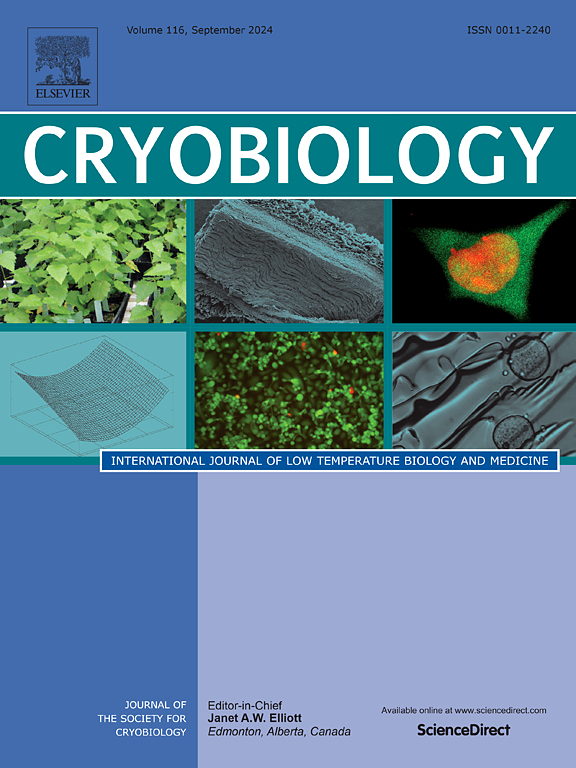猪流行性腹泻病毒作为SARS-CoV-2替代物的低温等时冷冻灭活研究
IF 2.1
3区 生物学
Q2 BIOLOGY
引用次数: 0
摘要
鉴于严重急性呼吸综合征冠状病毒2 (SARS-CoV-2)对冷冻食品的抵抗力,受污染的产品有可能成为病毒传播的媒介。然而,能够在零度以下的温度下灭活病毒而不影响食物的味道和质量的方法很少。在等时冷冻过程中自发产生的高压环境已被证明对抑制或灭活有害微生物(如细菌)有效;然而,其对冠状病毒的有效性及其机制尚不清楚。在本研究中,我们以猪流行性腹泻病毒(PEDV)作为SARS-CoV-2的代理病毒,研究了等时冷冻对PEDV传染性的影响,并评估了处理后病毒核酸和包膜完整性的变化以及抗原特性的变化。实验结果表明,经-20℃、201MPa等时冷冻处理6小时后,滴度下降1.18 log10(TCID50/mL)。虽然病毒核酸在治疗后保持完整,但包膜的完整性明显受损,导致传染性丧失。此外,病毒的抗原性在等线冷冻处理后略有增加。本研究率先探索了等时线冷冻技术对冠状病毒的灭活效果,包括初步机制,为管理冷冻食品中的冠状病毒污染提供了新的视角,并突出了等时线冷冻在疫苗灭活过程中的潜力。本文章由计算机程序翻译,如有差异,请以英文原文为准。
Inactivation of porcine epidemic diarrhea virus as a SARS-CoV-2 surrogate at sub-zero temperatures by isochoric freezing
Given the resilience of severe acute respiratory syndrome coronavirus 2 (SARS-CoV-2) on frozen food, there is a risk that contaminated products could serve as vectors for viral transmission. Yet, methods capable of inactivating the virus at sub-zero temperatures without compromising the food's taste and quality are scarce. The high-pressure environment that arises spontaneously during isochoric freezing has demonstrated efficacy in suppressing or inactivating harmful microorganisms, such as bacteria; however, its effectiveness against coronavirus and the mechanisms involved remain unclear. In this study, we employed Porcine epidemic diarrhea virus (PEDV) as a proxy for SARS-CoV-2 to examine the effects of isochoric freezing on PEDV infectivity and to evaluate post-treatment alterations in the integrity of viral nucleic acids and envelopes, as well as changes in antigenic properties. Our experimental findings indicate that after a 6-h isochoric freezing treatment at −20 °C and 201 MPa, the titer decreased by 1.18 log10(TCID50/mL). While the viral nucleic acid remained intact post-treatment, the envelope's integrity was significantly impaired, accounting for the loss of infectivity. Moreover, the antigenic properties of the virus showed a slight increase following isochoric freezing treatment. This study pioneers the exploration of isochoric freezing technology's inactivation effects on coronaviruses, including preliminary mechanisms, offering novel perspectives for managing coronavirus contamination in frozen food and highlighting the potential of isochoric freezing in vaccine inactivation processes.
求助全文
通过发布文献求助,成功后即可免费获取论文全文。
去求助
来源期刊

Cryobiology
生物-生理学
CiteScore
5.40
自引率
7.40%
发文量
71
审稿时长
56 days
期刊介绍:
Cryobiology: International Journal of Low Temperature Biology and Medicine publishes research articles on all aspects of low temperature biology and medicine.
Research Areas include:
• Cryoprotective additives and their pharmacological actions
• Cryosurgery
• Freeze-drying
• Freezing
• Frost hardiness in plants
• Hibernation
• Hypothermia
• Medical applications of reduced temperature
• Perfusion of organs
• All pertinent methodologies
Cryobiology is the official journal of the Society for Cryobiology.
 求助内容:
求助内容: 应助结果提醒方式:
应助结果提醒方式:


